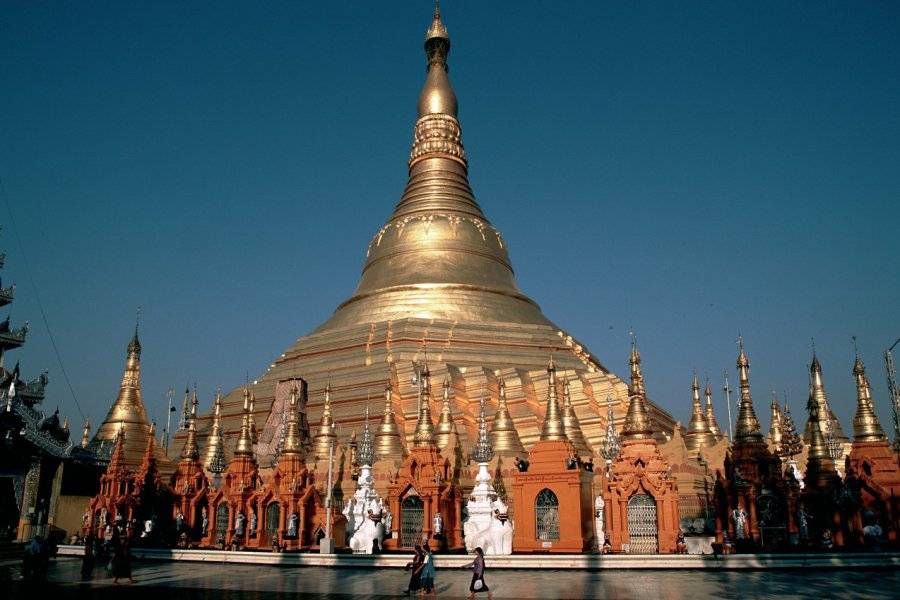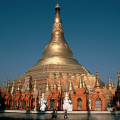SHWEDAGON PAGODA
The history of the Shwedagon pagoda is intimately linked to that of the Dagon site or the other way around. Either way, legend has it that the site's origin dates back to more than 500 years BC. Two merchants from India met Buddha and offered to share their honey cakes with him. Buddha thanked them by offering them eight of his hairs. On the way back, King Okkalappa cheered them on their arrival and gave a huge feast in honour of the sacred relics. The king then chose a site to erect a pagoda in which they would be enshrined. When the cassette containing the hair was opened, miracles happened. A first pagoda was built in gold, covered with several others in silver, pewter, lead, marble and finally brick.
The Shwedagon pagoda thus built was abandoned by the rulers until the 14th century. In 1362, King Byinnya U was the first to show interest in this sacred place: he decided to raise the pagoda by a few meters. Subsequently, many rulers were eager to make a gesture towards this monument. The most notable intervention was that of Queen Shinsawbu (1453-1472) who, after her accession to the throne of Bago, gave the dome its weight in gold: a featherweight of 40 kilograms, which, thanks to the fineness of the gold leaf, made it possible to cover the entire dome. Dhammazedi, his son, did even better by giving the pagoda a substantial gift: four times his weight in gold and that of his wife. He also had the legend of the pagoda written in Burmese, Mon and Pale, so that posterity will never forget how this building came into being.
Over the following centuries, the pagoda was in turn an object of covetousness, prey to the most devastating earthquakes, and a highly strategic location. In 1612, the Portuguese De Brito, more pragmatic than ever, wanted to seize the enormous bell of the pagoda to cast bronze and make cannons. But fate intervened: the weight of the bell sank the ship that carried the trophy. In 1774, King Hsinbyushin organized a splendid procession to bring from Ava a new umbrella that was to sit at the end of the stūpa. A similar initiative was undertaken by Mindon from the court of Mandalay in 1871. But the message was then charged with an undeniable political meaning. At that time, the British were occupying Lower Burma, and Mindon intended, by this supposedly harmless gesture, to testify to the greatness of its court in Mandalay.
As soon as they arrived in Burma, the British understood the strategic importance of Shwedagon, which they occupied from 1824. At the end of the Second Anglo-Burmese War, the pagoda was robbed by English soldiers. It was not until the 1930s that the building was freed from English rule.
Today, the pagoda is once again invaded, but it is a fervent crowd that crowds into its walls, each one fulfilling the dearest wish in a Buddhist life: to tread the ground of Shwedagon. The main entrance is to the south. This is where you will get the ticket valid for a whole day. The pagoda is accessed by four staircases that run from the four cardinal points to the central platform. This gives each entrance its own unique atmosphere. From the south entrance, a state-of-the-art Burmese elevator provides access to the platform in a single bound. The west entrance is accessed by an escalator, while the north and east entrances are reached by two large staircases that lead solemnly to the golden pagoda.
Around the stairs, numerous stalls offer the whole range of the perfect Buddhist: pretty paper umbrellas, flowers for offerings, Buddha statues, but also papier-mâché toys, musical instruments and a thousand other trinkets worthy of the greatest bazaars, with a Buddhist touch to boot.
Walking on the platform, one can make out more than sixty stūpa. Indeed, the large central stūpa, entirely covered with gold leaf every five years, is surrounded by a series of other stūpas of all sizes, the largest marking the four cardinal points.
One is quickly bewitched by the atmosphere and the effervescence that reigns in these places, at all hours. However, one should not forget to admire the richness of stūpa at its tip: the weather vane shines with a thousand diamonds and precious stones, and the upper sphere is set with diamonds that make the Sultan of Oman pale in colour. Perhaps you will also see the solitaire pointing at the end of the stūpa.
The pagoda is an amazing place where life is in full swing between the many tazaung. Each temple is dedicated to its donor. If you start the tour of the pagoda in a clockwise direction, as is the Buddhist tradition, you will first discover, in the south, a tazaung built in honour of Konagamana, the second Buddha of this world. If you were born on a Wednesday morning (and not in the afternoon, check your chronicles), a pillar is especially dedicated to you, associated with the planet Mercury. Going back west, the Saturday natives will see, with interest, the pillar of Saturn standing in front of them. Further on, a Chinese sanctuary contains twenty-eight images of Buddha.
Heading towards the southwest corner of the platform, we soon come face to face with two friendly nat, Thagyamin, the king of nat, and Bobogyi, who is in charge of protecting the Shwedagon pagoda. If, instead of these two figures, you see a Buddha lying along its eight meters, you have gone too far. Back to square one... (without earning twenty thousand francs!).
Among the statues and shrines that you will see later, note the sculpture of Mai Lamu and Thagyamin (the king of nat, always him), who gave birth to King Okalappa (the good king of legend, if you have followed the history of the pagoda carefully). Opposite, a pavilion is known as the "Two Penny Tazaung"; it is indeed thanks to small daily donations from all the merchants of Yangon that this sanctuary was built. On your way to the northwest, the altar of the days of the week associated with the planets allows you to revise your meager Buddhist knowledge on the subject.
You cannot miss the Mahagaunta bell. Certainly, the bell you have in front of you is not the original one, which has remained at the bottom of the water, we remember. It dates from the 13th century, but almost met the same fate as its sister. Indeed, the British also tried to take the bell away, not to make cannons out of it but as a trophy this time. En route, the ship sank, once is not customary. The British tried, in vain, to recover the bell, and finally called on the Burmese population to go and retrieve it. The Burmese were extremely resourceful, tying up as much bamboo and wood as they could to float the 16 tons that had been sunk. They succeeded in their goal and were able to retrieve the bell, here present.
To the northeast of the square are two banyan trees, the sacred tree under which Buddha experienced Enlightenment. Then follow sanctuaries and other small temples. According to the legend of Dagon, it is in this corner that there is an opening allowing access to the sacred hair embedded in the building. It is also through here that you can see the inscriptions of Dhammazedi and reread, in the text (if you are at the level in Mon, Pali or Burmese), the story of the sacred origin of the pagoda. The tour ends at the east side of the building, where another sacred tree rises. Depending on the time of day and daylight, all you have to do is choose the point from which you will have the best view of this dome of bewitching power.
Our advice: Visit the pagoda in the morning, either before 7am in the crowd of pilgrims or between 7am and 10am, in the quiet, before the sun is at its zenith. Then come back (with the same ticket) at dusk, enjoy the magic of the place.
Did you know? This review was written by our professional authors.
Members' reviews on SHWEDAGON PAGODA
The ratings and reviews below reflect the subjective opinions of members and not the opinion of The Little Witty.










il vaut mieux visiter le soir
l'ambiance est meilleure avec moins de touristes et plus de Birmans en prière